- Clone
- W17190B (See other available formats)
- Regulatory Status
- RUO
- Other Names
- CHIP, STIP1 Homology And U-Box Containing Protein 1, Carboxy Terminus Of Hsp70-Interacting Protein, RING-Type E3 Ubiquitin Transferase CHIP, E3 Ubiquitin-Protein Ligase CHIP, CLL-Associated Antigen KW-8, Antigen NY-CO-7, Heat Shock Protein A Binding
- Isotype
- Rat IgG2b, κ
- Ave. Rating
- Submit a Review
- Product Citations
- publications
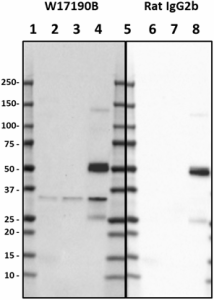
-

Western blot of purified anti-CHIP antibody (W17190B). Lane 1, 5: Molecular weight marker; Lane 2, 6: 20 µg of human spleen lysate; Lane 3, 7: 10 µg of mouse kidney lysate; Lane 4, 8: 10 µg of rat spleen lysate. The blot was incubated with 0.5 µg/mL of the primary antibody or Rat IgG2b isotype control overnight at 4°C, followed by incubation with HRP-labeled Goat anti-rat IgG (Cat. No. 405405). Enhanced chemiluminescence was used as the detection system. -

IHC staining of purified anti-CHIP antibody (W17190B) on formalin-fixed paraffin-embedded human spleen tissue. Following antigen retrieval using Sodium Citrate H.I.E.R (Cat. No. 928502), the tissue was incubated with 5 µg/ml of the primary antibody overnight at 4°C, followed by incubation with Biotin-labeled Donkey anti-rat IgG. BioLegend’s Ultra Streptavidin (USA) HRP Detection Kit (Multi-Species, DAB, Cat. No. 929901) was used for detection followed by hematoxylin counterstaining, according to the protocol provided. The image was captured with a 40X objective. Scale Bar: 50 µm -

IHC staining of purified anti-CHIP antibody (W17190B) on formalin-fixed paraffin-embedded mouse kidney tissue. Following antigen retrieval using Sodium Citrate H.I.E.R (Cat. No. 928502), the tissue was incubated with 5 µg/ml of the primary antibody overnight at 4°C, followed by incubation with Biotin-labeled Donkey anti-rat IgG. BioLegend’s Ultra Streptavidin (USA) HRP Detection Kit (Multi-Species, DAB, Cat. No. 929901) was used for detection followed by hematoxylin counterstaining, according to the protocol provided. The image was captured with a 40X objective. Scale Bar: 50 µm -

IHC staining of purified anti-CHIP antibody (W17190B) on formalin-fixed paraffin-embedded rat kidney tissue. Following antigen retrieval using Sodium Citrate H.I.E.R (Cat. No. 928502), the tissue was incubated with 5 µg/ml of the primary antibody overnight at 4°C, followed by incubation with Biotin-labeled Donkey anti-rat IgG. BioLegend’s Ultra Streptavidin (USA) HRP Detection Kit (Multi-Species, DAB, Cat. No. 929901) was used for detection followed by hematoxylin counterstaining, according to the protocol provided. The image was captured with a 40X objective. Scale Bar: 50 µm
| Cat # | Size | Price | Quantity Check Availability | Save | ||
|---|---|---|---|---|---|---|
| 865701 | 25 µg | $106 | ||||
| 865702 | 100 µg | $276 | ||||
CHIP is an E3 ubiquitin-protein ligase known to ubiquitinate misfolded chaperone-bound substrates and target them for proteasomal degradation. Hsp70, Hsc70, and Hsp90 are three chaperone proteins with which CHIP interacts. CHIP mediates polyubiquitination of DNA polymerase beta at 'Lys-41', 'Lys-61' and 'Lys-81', thereby plays a role in base-excision repair. CHIP can also negatively regulate the suppressive function of regulatory T-cells during inflammation by mediating the ubiquitination and degradation of FOXP3 in a HSPA1A/B-dependent manner. CHIP also negatively regulates TGF-beta signaling by modulating the basal levels of SMAD3 via ubiquitin-mediated degradation. Mutations in CHIP cause spinocerebellar ataxia type 16.
Product DetailsProduct Details
- Verified Reactivity
- Human, Mouse, Rat
- Antibody Type
- Monoclonal
- Host Species
- Rat
- Formulation
- Phosphate-buffered solution, pH 7.2, containing 0.09% sodium azide.
- Preparation
- The antibody was purified by affinity chromatography.
- Concentration
- 0.5 mg/ml
- Storage & Handling
- The antibody solution should be stored undiluted between 2°C and 8°C.
- Application
-
WB - Quality tested
IHC-P - Verified - Recommended Usage
-
Each lot of this antibody is quality control tested by Western blotting. For Western blotting, the suggested use of this reagent is 0.5 - 1.0 µg per ml. For immunohistochemistry on formalin-fixed paraffin-embedded tissue sections, a concentration range of 2.0 - 10 µg/ml is suggested. It is recommended that the reagent be titrated for optimal performance for each application.
- RRID
-
AB_2810779 (BioLegend Cat. No. 865701)
AB_2810780 (BioLegend Cat. No. 865702)
Antigen Details
- Structure
- CHIP is a 303 amino acid protein with an apparent molecular mass of ~ 35 kD.
- Distribution
-
Tissue Distribution: Brain, heart, skeletal muscle, kidney, liver, and spleen
Cellular Distribution: Cytosol, nucleus, and endoplasmic reticulum - Function
- CHIP is involved in protein ubiquitination, protein degradation, and neurodegeneration.
- Interaction
- Ubiquitin, ATXN3, EPHA2, SMAD3, UBE4B, VCP/p97.
- Cell Type
- Glutamatergic Neurons, Mature Neurons, Neurons, Tregs
- Biology Area
- Apoptosis/Tumor Suppressors/Cell Death, Cell Biology, Immunology, Neurodegeneration, Neuroscience, Signal Transduction, Ubiquitin/Protein Degradation
- Molecular Family
- Enzymes and Regulators, Heat Shock Proteins, Postsynaptic proteins, Phospho-Proteins, Protein Modifiers
- Antigen References
-
- Zhan S, et al. 2017. Int Rev Immunol. 36(5):300.
- Cao Z, et al. 2016. Oncotarget. 7(20):29864.
- Gene ID
- 10273 View all products for this Gene ID 56424 View all products for this Gene ID 287155 View all products for this Gene ID
- UniProt
- View information about CHIP on UniProt.org
Related FAQs
Other Formats
View All CHIP Reagents Request Custom Conjugation| Description | Clone | Applications |
|---|---|---|
| Purified anti-CHIP | W17190B | WB,IHC-P |
Compare Data Across All Formats
This data display is provided for general comparisons between formats.
Your actual data may vary due to variations in samples, target cells, instruments and their settings, staining conditions, and other factors.
If you need assistance with selecting the best format contact our expert technical support team.
 Login/Register
Login/Register 




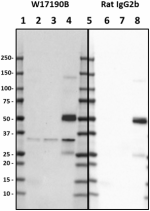
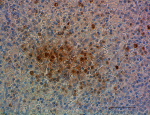
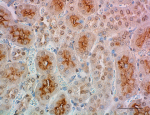
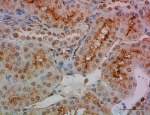



Follow Us